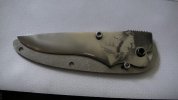- Joined
- Feb 16, 2010
- Messages
- 3,668
Here's the knife so far:

I'm not done with the scales yet, they are .063" 6al4v Titanium. I currently have three issues(that I know of)
1. The nylon washers I have are 3/8" diameter and 3/4" diameter. They are .02" thick. My blade is .07" thick. I really want to replace them with teflon washers that are .01" thick. This would give me a total inside width of .09". With .045" of thread, can I do this with 4-40 standoffs or do I need to use something smaller?
2. My old pivot was .21" diameter. The pivot hole in my blade is set for this, but I can only find pivots either 3/16" or 1/4". My current thoughts are to either make one from scratch, which would be a project in itself since I don't have a lathe, or find something smaller like a 7/32" that I can file down to size. Any suggestions?
3. My scales are 1/16" Titanium. How do I cut the liner lock without using cutoff wheels? I can figure out the short cut, but am uncertain about the long cut.
Also, on the blade, is the black stuff carbon and is there any way to remove it without sanding? I buffed a considerable amount of it off, but what remains wouldn't budge with the rouge I was using.

I'm not done with the scales yet, they are .063" 6al4v Titanium. I currently have three issues(that I know of)
1. The nylon washers I have are 3/8" diameter and 3/4" diameter. They are .02" thick. My blade is .07" thick. I really want to replace them with teflon washers that are .01" thick. This would give me a total inside width of .09". With .045" of thread, can I do this with 4-40 standoffs or do I need to use something smaller?
2. My old pivot was .21" diameter. The pivot hole in my blade is set for this, but I can only find pivots either 3/16" or 1/4". My current thoughts are to either make one from scratch, which would be a project in itself since I don't have a lathe, or find something smaller like a 7/32" that I can file down to size. Any suggestions?
3. My scales are 1/16" Titanium. How do I cut the liner lock without using cutoff wheels? I can figure out the short cut, but am uncertain about the long cut.
Also, on the blade, is the black stuff carbon and is there any way to remove it without sanding? I buffed a considerable amount of it off, but what remains wouldn't budge with the rouge I was using.
Last edited:



